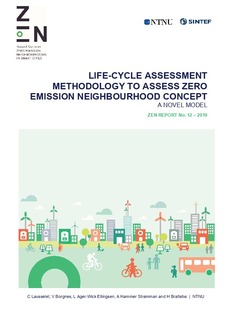| dc.description.abstract | Buildings represent a critical piece of a low-carbon future and their long lifetime necessitates urgent adoption of state-of-the-art performance standards to avoid significant lock-in risk. So far, life-cycle assessment (LCA) studies have assessed buildings (conventional and Zero Emission Building (ZEB)), mobility and energy systems mainly individually. Yet, these elements are closely linked, and to assess the nexus of housing, mobility, and energy associated with human settlements by aiming for Zero Emission Neighborhoods (ZENs) gives a unique chance to contribute to climate change mitigation. ZEBs and ZENs are likely to be critical components in a future climate change mitigation policy.
This study addresses the challenge of how to use LCA when implementing such a policy, in line also with the introduction of the more stringent Energy Performance of Buildings Directive in 2010 that requires new buildings to be built with nearly ZEB standards by the end of 2020. The specific aims of this report are fourfold. First, to develop and apply an LCA model to support the evaluation of ZEN design concepts with respect to greenhouse gas (GHG) emissions and other potential environmental impacts. Second, to clarify important contributing factors as well as revealing criticalities and sensitivities for GHG emission reductions and environmental performance of such ZEN design concepts. Third, to establish a model basis for other LCA studies on a neighbourhood scale, in terms of a high-quality modelling approach regarding consistency, transparency, and flexibility. Fourth, to apply our model on two cases; a hypothetical case of a neighbourhood consisting of single family house of passive house standard and on Zero Emission Village Bergen (ZVB).
For the first case, the neighbourhood consists of single-family houses built according to the Norwegian passive house standard. We designed four scenarios where we tested the impact of the house sizes, household size, energy used and produced in the buildings, and mobility patterns. Also, we ran our scenarios with different levels of decarbonization of the electricity mix over a time period of 60 years. … | |
